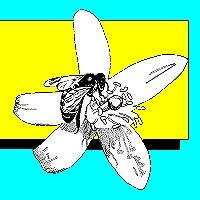APIS Volume 7, Number 4, April 1989

In this issue
- Extension Apiculturist on Sabbatical
- Importing Bee Stock--Costs and Benefits
- Tracheal Mite Assessment in California
- The Pesticide Treadmill and the Beekeeper
EXTENSION APICULTURIST ON SABBATICAL
I have been awarded a faculty development grant (sabbatical) to study beekeeping practices in middle Europe this summer. I plan to spend most of my time in Italy, but also to travel to neighboring countries should time permit. The basis for my proposal is to look at beekeeping research and extension activities in areas infested with tracheal and Varroa mites. According to a recent issue of Bienen Stich, published by Ciba-Geigy chemical company, Italy has become one of the leading countries in apiculture. Some 75,000 beekeepers manage about 900,000 colonies for honey, royal jelly and queen production in the country. There is also an established sector providing pollination services.
Italy has a long tradition in bee research and extension. These activities are carried out at the National Institute of Beekeeping in Bologna and through Institutes of Entomology and Zootechnics at the universities of Bari, Catania, Florence, Milan, Perugia, Pisa and Udine. There is also an Institute of Agrarian Entomology and Apiculture in Turin. Italy is a center of parasitic mite research. A meeting of the twelve-nation European Economic Community met in Udine recently to discuss progress against Varroa. Italians have been involved in research on tracheal mites since the 1960s. Other subjects are also under study in the country. These include bee forage, bee products, pollination of crops, financial management, and effects of pesticides.
Although I will be out of the country, I still plan to continue publishing APIS on a monthly basis. As it stands now, I will be leaving the last part of May, probably returning in November. Routine questions can be answered by Ms. Glinda Burnett, my secretary for eight years and Frank Robinson's for many years before that, who knows a great deal about Florida's beekeeping industry. She also personally knows many beekeepers. She and I expect to remain in contact through international computer networks while I'm away so that any emergency situation that arises will be brought to my attention.
IMPORTING BEE STOCK--COSTS AND BENEFITS
Ever since introduction of Varroa, there has been a good deal of discussion about importing resistant bee stock. In his latest issue of Apiculture Awareness, Dr. Jim Tew writes that the Agriculture Research Service (ARS) of the USDA is proposing to import germ plasm of Apis mellifera carnica, the carniolan bee, from Yugoslavia. The reason is to provide a selected stock of bees that will give a 5-year advantage in the development of honeybee stock resistant to Varroa.
Others have also called for importation. Dr. Elbert Jaycox in The Newsletter on Beekeeping (March, 1989) says we must have honey bee stock resistant to both tracheal and Varroa mites in order to free ourselves of the very real damage that pesticide residues in honey might cause. He suggests looking at many sources including African hybrids now found in Mexico. And Steve Taber in his latest Honey Bee Genetics Newsletter says: "The so-called killer bee (AHB) is resistant to Varroa, it tolerates it in the hive. According to what I have read from studies in Brasil it reduces honey production perhaps 5% and no treatment against the mite is ever used. I think we need these bees here and now so we can start a breeding program using the AHB as a basis for our fight against Varroa. At present we know that Varroa kills all European colonies of bees."
Unfortunately, many of the specifics for the above proposals are not clear. Surely we need resistant stock, but is importation the only solution? Under what conditions will it be safe? Do we really want to import bees with the public relations image of the Africanized strain? Many are heeding the call to bring in stock no matter the cost; others say this would be a great disservice to the beekeeping industry. Unfortunately, this is creating confusion during a time when clear thinking is absolutely necessary. The result of this is some beekeepers hinting that those most affected should take action themselves. This would be to illegally import bees from Europe and/or Africanized honey bee stock from Brazil.
Dr. H. Glenn Hall, honey bee geneticist at the University of Florida recently wrote a letter to the State Apiarist, Mr. Laurence Cutts, concerning illegal importation of Africanized stock. He stated:
- The importation of bees or bee semen into the U.S. is illegal. The original introduction of African bees in Brazil was by a competent geneticist, and yet the African bee unpredictably got out of hand. Introduction of the African bee into Florida at this time would create the problem five years in advance of what is expected. An earlier introduction would do additional damage to the economy of Florida. This would likely result in the full force of the State Attorney General's office to come to bear on the beekeepers responsible.
- African bees do not produce a good honey surplus and would be of limited value, even if Varroa resistance were expressed...Escaped African bees, especially mother lines, could establish a feral population very competitive with managed bees, further reducing honey yields.
- Knowing that beekeepers were responsible for the introduction, the public will call for strict regulations against them and will never in the future believe publicity campaigns promoting the need and value of beekeepers as a defense against the African bee. Reports of a major African bee introduction would likely result in federal and other state quarantines against Florida. Migratory beekeepers would suffer.
- The already short amount of time still remaining to conduct research and prepare for the African bee would be eliminated. We would have to deal with the problem without benefit of experience from other states. Introductions into Florida at this time would complicate baseline data and would seriously compromise effectiveness of identification methods being developed.
Dr. Orley Taylor at the University of Kansas has also written Mr. Cutts providing his thoughts on the issue. "In late 1983 and 1984 I heard many rumors that beekeepers in Florida were planning on importing Africanized bees from South America. The reasons given to justify such illegal introductions was the supposed superior honey production of Africanized bees. I was astounded by such reasoning since there was no data supporting such claims and it was completely contrary to my personal experience. At that time I didn't know what to do about these rumors and I thought it was unlikely beekeepers would be so foolish as to intentionally introduce Africanized bees."
As a followup, an "uncritical" article by Dr. David DeJong inspired Dr. Taylor to write a commentary published in the May, 1984 American Bee Journal. He concluded by strongly cautioning against importations of the Africanized honey bee into other regions without thoroughly establishing the costs and benefits of such an introduction.
"For the last six months," Dr. Taylor's letter continues, "there have been persistent rumors that Florida beekeepers are planning on introducing African bees--this time because of the belief (again not substantiated by quantitative data in the literature) that African bees are more resistant to Varroa mites than are European populations...A large introduction followed by intentional propagation of these bees would certainly lead to the establishment of a feral population which would rapidly spread throughout Florida. Stinging incidents involving feral or managed bees with African characteristics would be costly to the state."
"Throughout the country beekeepers are beating the drum to develop good will with the public with the intent of minimizing the regulatory response that is likely to follow the natural invasion by Africanized bees in Texas in 1990. Beekeepers and scientists alike are arguing that beekeepers must become part of the solution to the Africanized bee problem. An intentional introduction of Africanized bees by selfishly motivated beekeepers, who are ignoring a potential public health problem, would undermine the relationships beekeepers are trying to establish with lawmakers and the public."
Dr. Taylor concludes:
"Some type of official warning is needed and it should be clear to beekeepers that with techniques that are now available, Africanized bees, even in the form of feral swarms issuing from apiaries could be traced to their apiaries. In other words, introductions of African bees will be detected and any beekeeper making such an introduction could be liable to the full extent of the law--a truly serious consequence should stinging incidents be involved."
The debate concerning importing bee stock goes on. It will no doubt be decided after a good amount of debate and critical thinking. No one, however, believes that random introduction of stock by beekeepers in the vain hope that this might mitigate severe problems the industry now faces is anything but a prescription for disaster.
MITE ASSESSMENT
Dr. Eric Mussen recently wrote an article in his newsletter,From the U.C. Apiaries on mite tracheal mite assessment. Dr. Mussen says, wintering populations were up in California and there was increased awareness of tracheal mites. Many beekeepers had their colonies checked and mites were found. A number of beekeepers who suffered severe losses in previous years due to malnutrition fed pollen substitute and syrup and also treated for mites.
Most properly treated bees seem to be coming through the winter fine. Untreated colonies are in trouble, but not across the board. What is known is that certain beekeepers are seeing some of their colonies dwindle down to queenright populations the size of softballs. The bees act like they are narcotized or cold. Sometimes they crawl out of the hives en masse, some with disjointed or "K-wings." Examination shows only 50-60 percent mite infestation.
Dr. Mussen analyzes the situation this way: "If the mites were directly responsible for this condition, then all the affected bees should be infested. Instead, it appears as though the whole colony population suffers evenly although only a portion of the bees are infested. We know that clusters of bees will share resources. That sharing can keep a cluster going as a group, long after the same bees would have died if they were isolated singly. So what is the 'shared problem'?" He suggests it might be depletion of body nutrients and/or distribution of a toxin or some infectious organism. Dr. Mussen concludes, "Whatever the cause, it is obvious that some of our populations of bees cannot handle a tracheal mite infestation during the winter and survive or be utilizable colonies in the spring."
THE PESTICIDE TREADMILL
Beekeepers and scientists are becoming nervous. The beekeeping industry has quickly taken to using pesticides to solve its mite problems. This is suspiciously similar to the road taken by much of production agriculture before the advent of integrated pest management. It cannot be said too many times that getting on the pesticide treadmill is all too easy. Getting off is another story and more difficult to accomplish as time goes on.
Recent news stories concerning pesticides in apples and purposefully tainted Chilean grapes have brought about renewed interest in organically grown produce. Honey has achieved a reputation through the years as one of the most "organic" of products. Please keep this in mind as you establish your plans for the next honey producing season.
Malcolm T. Sanford
Bldg 970, Box 110620
University of Florida
Gainesville, FL 32611-0620
Phone (904) 392-1801, Ext. 143 FAX: 904-392-0190
http://www.ifas.ufl.edu/~entweb/apis/apis.htm
INTERNET Address: MTS@GNV.IFAS.UFL.EDU
©1989 M.T. Sanford "All Rights Reserved





















